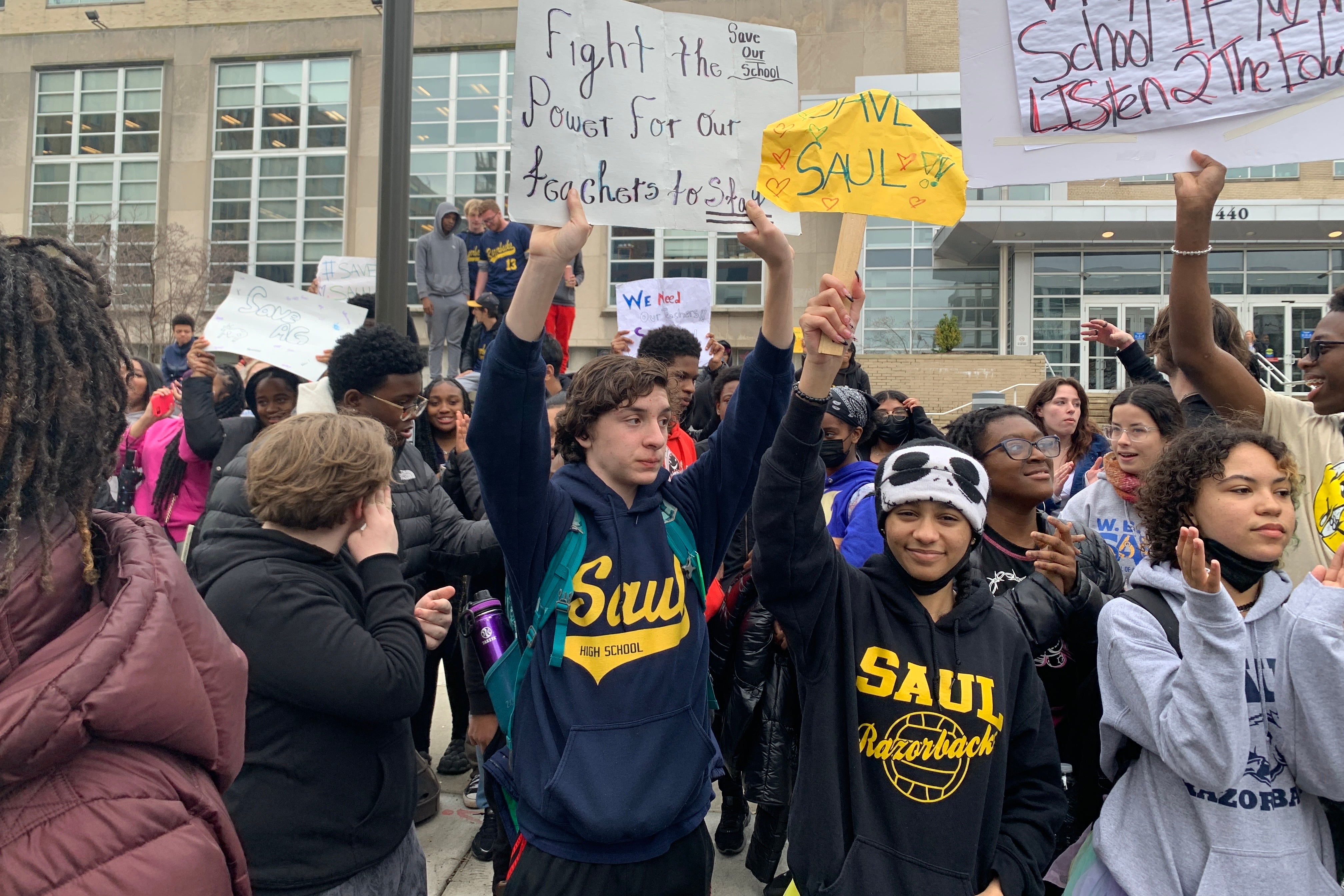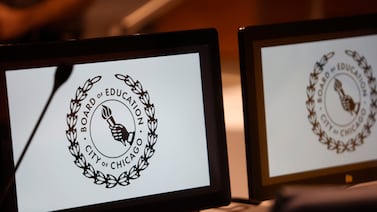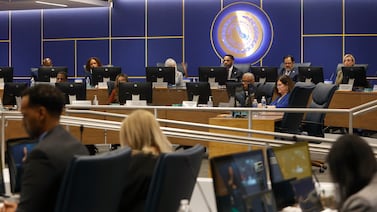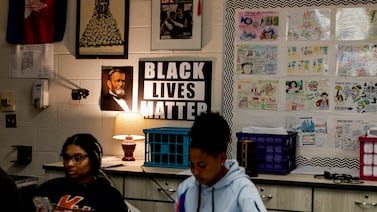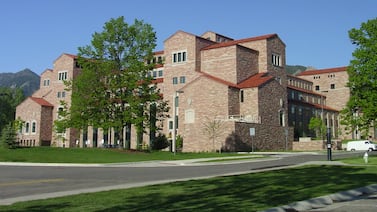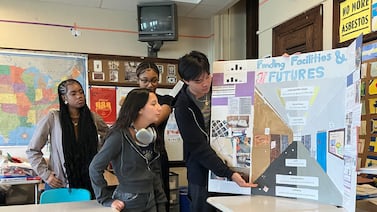More than 100 students and some teachers rallied before the Board of Education meeting Thursday to protest how the lottery system for citywide and selective admission high schools is causing huge enrollment drops for many of next fall’s incoming classes.
The declines mean that schools will lose staff positions and many teachers will be reassigned, since teacher allotments are done in the spring based on anticipated fall enrollment. This will destabilize these schools, demoralizing both staff and current students, teachers said.
The centralized lottery system was imposed in 2021 due to concerns about equity and access for Black and brown students to some of the city’s most coveted schools. The lottery also represented an effort to address any “implicit bias,” officials said at the time. It replaced a longstanding process in which principals made the final admissions decisions from the pool of qualified applicants.
Officials said allowing principals to make those calls resulted in a preponderance of white and Asian students at schools like Central and Masterman, even though 80% of the district’s students are Black and Latino. The lottery system also gives preference to students from six ZIP codes that rarely send students to selective schools.
But this year, teachers say, based on current enrollment projections, the lottery process is having dire consequences for a group of themed and innovative high schools that serve mostly Black and brown students. Many of those schools have relatively small enrollments.
“How is this equity?” asked teacher Jessica Way, who runs a medical assistant program at Franklin Learning Center. At her school, there are slated to be 50 open seats in next year’s freshman class and enrollment is projected to dip from nearly 1,000 students in 2020-21 to fewer than 800 next year.
At Thursday’s protest, one student held up a sign referring to fears about staffing cuts at Saul High School. “Saul has no future with no teachers,” the sign said.
“We only have 55 new freshmen and we would normally have 150,” said Deonna Brown, a Saul sophomore.
In the wake of the protest, Superintendent Tony Watlington issued a statement — and then said at the Board of Education meeting Thursday — that the district will devote $3 million to ensure that no school will lose more than two staff members, “subject to principal discretion.”
Watlington also said the district will offer spots at schools with admission criteria to 316 students who qualify for one or more of the schools with admission criteria, but are currently slated to attend their neighborhood schools. He said at the board meeting that more eighth graders met criteria this year under the lottery system than prior to the pandemic, but added that “there are still kinks to work out.”
Board of Education President Reginald Streater, who with other board members watched the rally, said in an interview that the district plans to audit the lottery process and that it could change next year.
“Right now, we’re in Band Aid mode,” he said.
Before the intervention Watlington announced Thursday, the Franklin Learning Center was due to lose as many as nine staff members, Way said.
Elsewhere, teachers said that only 17 students are slated to enter ninth grade at Bartram Motivation, a small high school that offers research-based learning and dual enrollment with Harrisburg University, leaving it with 90 open ninth grade seats.
Other schools with severely under-enrolled incoming freshman classes include The U School, The LINC, Science Leadership Academy at Beeber, Hill-Freedman, and Saul, the state’s only high school that focuses on animal science and agriculture.
Because Saul was projecting such a small ninth grade class, it was slated to lose six teachers before Watlington’s announcement Thursday, and its agriculture program could be affected, teachers said.
At the same time, there are hundreds of students who are still awaiting school placements because they had no luck with the lottery and have shown interest in one or more of these schools.
For those criteria-based schools, in past years, school personnel would be able to interview students who may have fallen just short of qualifying — for example, they may have had good grades and attendance, but maybe two Cs instead of just one, or a score just below the cutoff on the state standardized test. This year, they cannot do that, Way said.
“Normally there was some wiggle room,” she said. “This year, there was no wiggle room.”
Several Saul students at the rally said they felt that low Pennsylvania System of School Assessment scores were the main reason for the low number of students in the incoming freshman class. Last year, the first time the lottery system was used, those tests were not a factor because they weren’t given due to the pandemic.
‘Kids are more than a number’
In the new, centralized selection process, eighth graders list five high schools and are entered into the lottery of all the schools for which they meet qualifications. Some students get into all five, some to none. The default for any student is their neighborhood high school.
The most highly selective, like Central and Masterman, have stringent grade, test score, behavior, and attendance requirements. The so-called citywide schools have less rigorous criteria regarding grades and test scores, but generally expect good attendance and behavior records.
Once students make their choices, wait lists are created and the process continues until all students are placed.
Some citywide admissions schools, like The U School, have no grade or test score minimums, but must build its class from students who show interest in its model and put it on their list.
Teachers say that the prolonged loss of in-person learning due to COVID is also contributing to the enrollment drop. For some small high schools like The U School, their very viability is threatened.
The U School was established in 2014 to serve students interested in an education that prioritizes personal relationships and real-world learning through internships and partnerships and has no academic cutoffs. The school’s pre-pandemic enrollment had been as high as 400. But based on current projections, the school could have fewer than 200 students when schools open in September and could lose four staff members.
“We rely a lot on school visiting and the [annual] high school fair, but all that stuff was shut down due to COVID,” said Donovan Hayes, a math teacher at The U School. “It’s hard to get kids to write down a school when they’ve never heard of it.”
He said that Principal Neil Geyette wanted to extend invitations to all the students who had put The U School down as one of their choices, about 137 additional students, but was told he could not do that.
Besides the medical assistant program, FLC offers a focus on dance, music, and other arts. Under the old system, principals could determine if students “had a natural interest in the majors at our school. We want kids [who can meet standards] of academic rigor,” Way said. “But kids are more than a number. If you take out the human equation, it takes away the ability to see our kids fully.”
Another repercussion concerns teacher recruitment and retention. The district opened the school year with at least 200 vacancies and is still struggling to hire enough teachers.
Sigal Felber has been working in the district for two years and teaches U.S. History to sophomores at FLC.
“One of the reasons I decided to come [to FLC] is its unique programs,” Felber said. Besides the medical assistant program, it also offers performing arts, visual arts, and business tracks. To Felber, it made sense to interview students to see if they were interested in what the school had to offer.
If FLC loses nine teachers, as was projected before Thursday, two of them will be from the social studies department. And because Felber is so new, “one of them will be me.”
This story has been updated.
Dale Mezzacappa is a senior writer for Chalkbeat Philadelphia, where she covers K-12 schools and early childhood education in Philadelphia. Contact Dale at dmezzacappa@chalkbeat.org.

